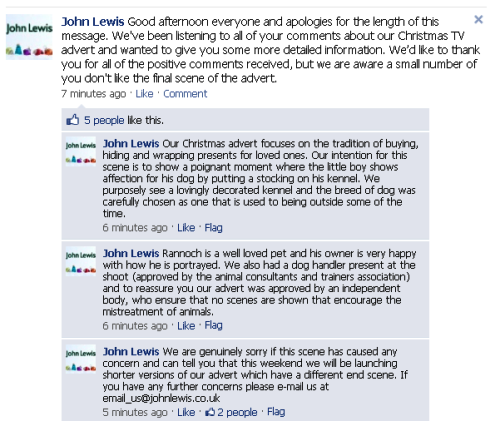To the walls!
December 3, 2010 11:11 AM
What to do when your brand is under attack?
More and more companies are going social and have established a presence online as a means of engaging directly with their target audience and building communities around their products or services. As most social media departments will know, when starting a campaign it is always important to monitor the brand to find out why, what and where they are being talked about. This will give the campaign a structure when setting up profiles on various social media platforms and creating engaging content, whether it's in the form of a blog post, tweets, video, etc. There is quite a lot of work involved when setting up and executing what a business might think is the perfect social media plan and strategies.
What happens when it all goes wrong & the consumers start to attack a brand? In the last couple of weeks I followed the John Lewis group on Facebook. The company had been subjected to a series of verbal attacks for advertising their Christmas video. The video was advertising their Christmas message, which caused somewhat of an uproar towards the end of the video when it showed a child coming out to hang a stocking on his dog's kennel, with the dog sitting outside in the snow. This prompted animal lovers to complain about animal cruelty in there droves. A series of very negative mentions continued to pour onto the Facebook page over the next few days.
To view the video: http://www.youtube.com/watch?v=mpV-xagkTDU
When you are an established brand, how do you deal with such a series of negative mentions?
Firstly, you need to listen to the key points of contention to gain an idea of how to approach and placate the audience. The worst thing a brand can do is shy away and ignore comments being made as brand credibility will be lost immediately, which could potentially lead to a loss of sales/loyalty. The audience are giving their feedback and they will at some point want to be have their concerns and opinions addressed by the brand.
John Lewis monitored their Facebook page and with the initial comments, simply passed on the complaints email address. As momentum built however, this was not feasible and it became apparent that they would have to address the issue 'en masse.' After a day or two John Lewis released the message below:

This message was intended to reassure the audience with the tone that they adopted, and offering a willingness to make a shorter version of the advert. Since then there were still negative comments being made, however, the Facebook wall was updated the next day with a resumption of their normal social media activity.
This is a great example of how a brand or a large business tries to resurrect their brand's image. Above, I touched on 'the tone that John Lewis adopted,' and wanted to further explain this. A company's tone is extremely important in social media as a means of defining the brand's values and bringing recognition for the sort of company that they are. It is therefore really important to understand the brand so think about the tone every time a response is required. It's not the end of the world when your brand receives negative mentions, act on it sensibly and you will either sway those criticising or you will take the emotion out of the equation.
On a final note, I obviously had an opinion on John Lewis's Christmas advert and I was for keeping the old advert. This was simply because it was meant to depict a light-hearted scene, cleverly designed to evoke positive emotions related to the Christmas season.






6 Comments
Steve Morris
Interesting post Krupa. I think such a well established and 'clearly defined' (in the public's imagination) high street brand like John Lewis played it about right. For as many negative comments as there were they would have monitored the conversation and seen there were many perplexed and frustrated by the furore. JL did well not be too reactionary - they obviously took stock and made a judgement, deciding to steer clear of further offending the dog lovers whilst carefully avoiding 'giving in' completely and allowing a vocal minority to set the agenda. Fair, unfussy and honest - bang 'on message' from them I'd say.
Diago W
That is some good food for thought Krupa. I think Steve has a good point about John Lewis not being to reactionary and not 'giving in' with their response. I thought they handled it well however I also have to say that I think it also brings to light a frustration that must exist with a lot of big brands, and that would be dealing with the over zealous and at times petulant nature of consumers. I would be curious to see the contrast between how much 'fire fighting' big brands do vs the amount of praise they get...I imagine the variance is startling.
David Williams
There are some nice thoughts in that. I am particularly interested in your comment Krupa on this being an example of how a business tries to 'resurrect' their Brand. My thought is that a brand can't be resurrected but in social media a brand is evolving through the whole situation so in the end a slightly newer brand is formed. I say this because every crisis, every success and every comment creates perceptions in a users mind and I don't think messaging can be so targeted and specific that the 'planned' image of a brand is ALWAYS presented. I don't think a company has that much control because you're dealing with human beings.
(P.s. Great title for the blog)
(P.p.s. The dog I had lived outside)
Mark W. Schaefer
This is one to keep Krupa. Well done! Relevant and timely.
Krupa Patel
Thanks for your input Steve, Diago, David & Mark, your comments have been an interesting read.
My thoughts exactly David, consumers have been unpredictable since the beginning of time, social media has been a way of giving the consumers a voice! John Lewis have done well and I have a new found respect for the brand.
While this is an example from the world of consumer marketing, B2B brands, talk from one person to another and are just as exposed to potential customer backlash and also need to be aware of how best to deal with it.
Gabriel Ralls
It's also worth mentioning that many brands will continue as usual despite negativity that may surround them at the time. Nesle is a prime example. People are of course still aware (and still angry) of their past (and current) exploits, but it hasn't stopped them selling product.
Another example you could look at is with Vodafone and the current situation with David Cameron cutting their debt. While it will make many people furious, ultimately leaving their phone contracts and moving will be more of a hassle than not and so Vodafone will continue as usual in the longrun.
I'm personally not affected by the John Lewis advert - as many dogs are (as they point out) used to being outdoors much of the time. Still, letting the brand know you're not happy with their course of action is still worthwhile to ensure that they take a more careful stance in future.
Reply